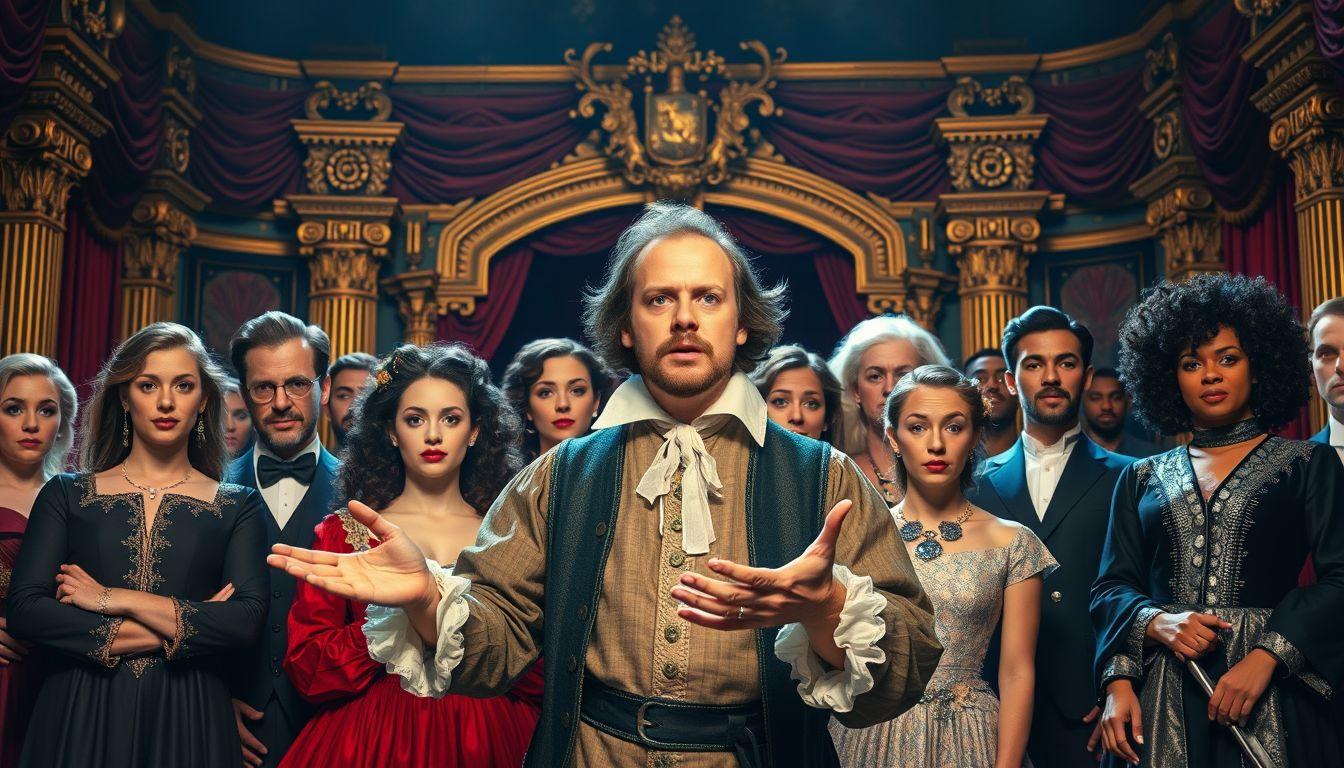Liputan6.com, Jakarta The famous line "to be or not to be" comes from a play called Hamlet. William Shakespeare wrote this play many years ago. This quote is one of the most well-known lines in English. People all over the world know these words. The quote talks about life and death. It asks if living is better than dying. Many students learn about this quote in school. It helps us think about big questions in life.
2 of 11 pages
What Does To Be or Not to Be Mean

- The quote asks if we should live or die
- It means choosing between existing and not existing
- The words talk about making hard choices in life
- It asks what is better for a person to do
- The quote makes us think about our problems
- It wonders if life is worth living when things are hard
- The words mean we must decide how to face troubles
- It asks if fighting problems is better than giving up
- The quote talks about being brave or being scared
- It means thinking carefully before making big decisions
- The words ask if we should accept bad things that happen
- It wonders if we should try to change our situation
- The quote talks about the fear of what comes after death
- It means we often stay with problems we know
- The words suggest that thinking too much can stop us from acting
Advertisement
3 of 11 pages
Who Said This Famous Quote

- Prince Hamlet is the character who speaks these words
- Hamlet is the main person in Shakespeare's play
- William Shakespeare created this character and wrote the words
- Shakespeare lived in England about 400 years ago
- He wrote many plays and poems that people still read today
- Hamlet is a prince who has many problems in the story
- The character speaks these words when he is alone on stage
- This type of speech is called a soliloquy
- In a soliloquy, the character talks to himself
- Other characters in the play cannot hear what he says
- The audience can hear the character's private thoughts
- Hamlet says these words in Act 3 of the play
- This happens in Scene 1 of that act
- The scene is sometimes called the nunnery scene
- Ophelia is also in this scene but she cannot hear Hamlet at first
4 of 11 pages
The Full Speech and Its Simple Meaning
- The speech starts with "To be, or not to be, that is the question"
- Hamlet asks if it is better to suffer bad things quietly
- He wonders if fighting against troubles is the right choice
- The speech talks about ending problems by ending life
- Hamlet compares death to sleeping peacefully
- He thinks death might end all the pain and worry
- But then he worries about what dreams might come in death
- He fears that death might not be peaceful after all
- The speech lists many problems that people face in life
- These include unfair treatment and broken hearts
- It mentions slow courts and rude officials
- Hamlet talks about good people being treated badly
- He wonders why people put up with these problems
- The answer is that people fear what happens after death
- Nobody knows what the afterlife will be like
- This fear makes people choose to keep living
- Hamlet says thinking too much makes people afraid to act
- He believes that overthinking stops people from doing things
Advertisement
5 of 11 pages
Why This Quote Is So Famous
- The words are simple but talk about deep ideas
- Almost everyone has heard this quote before
- It appears in many movies and TV shows
- Students learn about it in English classes around the world
- The quote asks questions that all people think about
- It talks about problems that everyone faces
- The words are easy to remember
- Many phrases from this speech are used in everyday talk
- People quote parts of it when they face hard choices
- The speech has been translated into many languages
- Actors love to perform this famous speech
- It shows Shakespeare's skill with words
- The quote has influenced many other writers
- It appears in books, songs, and poems
- People use it to talk about life's big questions
6 of 11 pages
Different Versions of the Speech

- There are three main versions of Hamlet's play
- The First Quarto was published in 1603
- This version is quite different from the others
- The Second Quarto came out in 1604
- This version is considered the best one
- The First Folio was published in 1623
- Each version has slightly different words
- The spelling in old versions looks strange to us now
- Modern versions use updated spelling
- The meaning stays the same in all versions
- Scholars study the differences between versions
- Some words were changed over time
- The punctuation is different in each version
- All versions contain the famous opening line
- Each version helps us understand Shakespeare's work better
Advertisement
7 of 11 pages
How This Quote Appears in Movies and TV

- Many movies have used this famous quote
- Actors often perform the full speech in films
- Some movies make jokes about the serious words
- Arnold Schwarzenegger said "To be or not to be? Not to be" in a movie
- Charlie Chaplin performed the speech in one of his films
- Star Trek movies have referenced these words
- The quote appears in comedy shows and cartoons
- TV shows often use parts of the speech
- Characters quote it when making hard decisions
- The words are used in movie titles and book names
- Many actors consider this speech a test of their skill
- Drama schools teach students to perform this speech
- It appears in both serious and funny contexts
- The quote is recognized by audiences everywhere
- Directors use it to show a character's deep thinking
8 of 11 pages
What Life Problems the Speech Talks About

- The speech mentions unfair treatment by powerful people
- It talks about proud people who look down on others
- Love that is not returned causes pain
- Courts and legal systems work too slowly
- Government officials can be rude and unhelpful
- Good people often get treated badly
- Hard work is not always rewarded fairly
- People face criticism and mockery from others
- Life can feel like carrying a heavy load
- Everyone experiences heartache and disappointment
- Natural disasters and accidents happen to everyone
- Growing old brings pain and weakness
- Society can be cruel to those who are different
- Money problems cause stress and worry
- These problems make people wonder if life is worth living
Advertisement
9 of 11 pages
What the Speech Teaches Us About Fear
- Fear of the unknown keeps people from taking action
- We fear death because we don't know what comes next
- This fear makes us accept problems we could change
- Thinking too much about consequences stops us from acting
- Fear makes cowards of brave people
- We choose familiar problems over unknown solutions
- The speech shows that fear is natural and human
- Even princes and powerful people feel afraid
- Fear can protect us but also hold us back
- Conscience and moral thinking add to our fears
- Religious beliefs affect how we think about death
- Fear of punishment after death influences our choices
- The speech suggests that some fear is wise
- But too much fear prevents us from living fully
- Understanding our fears helps us make better choices
10 of 11 pages
Simple Lessons from This Famous Quote

- Life has both good and bad parts
- Everyone faces difficult times and hard choices
- It's normal to feel overwhelmed by problems
- Thinking about our choices is important
- But thinking too much can stop us from acting
- Fear is a natural part of being human
- We should face our problems instead of running away
- Death is mysterious and that's okay
- Living requires courage and strength
- Even when life is hard, it has value
- We can learn from characters like Hamlet
- Literature helps us understand our own feelings
- Asking big questions about life is healthy
- We don't have to face our problems alone
- Every person must find their own answers to life's questions
Advertisement
11 of 11 pages
Why Students Still Learn This Quote Today
- The quote teaches important lessons about life
- It helps students think about big questions
- Shakespeare's words are still relevant today
- The quote shows how language can be beautiful and powerful
- Students learn about English literature through this speech
- It connects modern students to history and culture
- The quote encourages deep thinking and discussion
- Teachers use it to talk about difficult topics
- It shows that people have always faced similar problems
- Students can relate to Hamlet's feelings and struggles
- The speech improves students' reading and speaking skills
- It introduces students to classic literature
- The quote appears on many important tests
- Understanding it helps students in college and beyond
- It proves that good writing lasts for many centuries
:strip_icc()/kly-media-production/avatars/1860534/original/066891900_1744691596-WhatsApp_Image_2025-04-15_at_11.32.22_686af95d.jpg)
:strip_icc()/kly-media-production/medias/5280001/original/029555900_1752204462-aE5kLyjiJr.jpg)
:strip_icc()/kly-media-production/medias/1578770/original/063077900_1493294965-6__Shakespeare__ranah_publik.jpg)
:strip_icc()/kly-media-production/medias/3165902/original/014958300_1593489698-shakespeare-3422028_1920.jpg)
:strip_icc()/kly-media-production/medias/4221875/original/096927900_1668073734-william_shaekeke.jpg)
:strip_icc()/kly-media-production/medias/4993819/original/002178800_1730894890-murid-adalah.jpg)